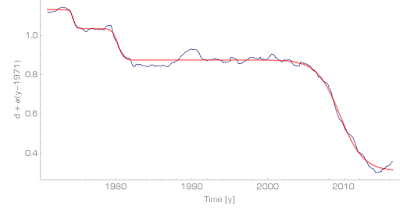FRED has updated the data on the number of vehicle miles driven, and it looked to me like a perfect candidate for a "growth equilibrium state" analysis using minimum entropy like I did for unemployment (see that post for more details about the process). Here is the original data:
The growth rate bins (note this is not a log-linear graph, so these are not exponential growth rates, but rather linear growth rates) look something like this:
The slope that minimizes the entropy is about α = 0.062 Mmi/y ("dr" is the data list and "DR" is an interpolating function of the data list):
And here is the minimized entropy distribution (i.e. the "spikiest" distribution):
Subtracting that trend and fitting a series of logistic functions (Fermi-Dirac distributions) to the data gives a pretty good fit:
The center of the transitions are at 1974.4, 1980.3, and 2009.5 -- corresponding to the three longest recessions between 1971 and 2016. This results in a pretty good "model" of the number of vehicle miles traveled:






Sorry to be off topic here. I don't know if you still bother with Scott Sumner but he's on another NGDP futures targeting rant.
ReplyDeleteHe's convinced this is the idea that will save the monetary world. Honestly I find it funny how he gets when Noah Smith criticizes it.
http://econlog.econlib.org/archives/2016/07/noah_smith_refu.html
http://www.themoneyillusion.com/?p=31856
Anyway, do you have an opinion about this idea of NGDP futures targeting?
I recall you criticizing Sumner before but not specifically whether it was about this.
Yeah, I defer to Noah and Mike Sankowski in terms of understanding the problems with the futures market (I have my own issues with prediction markets here).
DeleteMy issues with Sumner centered around his sloppy data analysis and the fact that market monetarism isn't falsifiable.